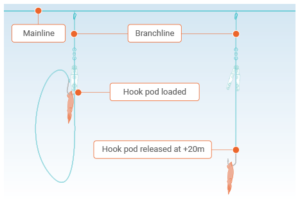Hookpod™
WHAT ARE HOOKPODS™?
Hookpods™ are designed to mitigate seabird bycatch in pelagic longline fisheries. Seabirds are at risk of entanglement, injury and death as they feed on bait attached to longline hooks. The Hookpod™ is a simple hook protection device designed to reduce this interaction. During the deployment of longlines, the baited hooks are individually loaded into a Hookpod™ to encase the sharp barb until, at a predetermined depth, the pressure release system releases the hook. Now safely beyond the diving depths of seabirds, risk of seabird bycatch is greatly reduced whilst target catch rates remain unaffected.
Engineered with a built-in weight, the Hookpod™ also acts as a form of line weighting, replacing the need for lead weights, over which fishermen have raised safety concerns. This device is designed to be easy to use and to last for up to 3 years.

Source: Hookpod
CURRENT RESEARCH & USE
Patented in both the EU and in New Zealand, the Hookpod™ has undergone successful trials since its inception in 2007. Trials in the New Zealand tuna surface longline fishery in 2016 reported complete elimination of seabird bycatch with no reduction in target catch. Further trials in Australia lead to the Agreement for the Conservation of Albatross and Petrels (ACAP) recommending the Hookpod™ as “best practice mitigation in the longline industry”. Recommended as a stand-alone measure owing to its effectiveness, the device became a legal requirement in the New Zealand surface longline fishery in January 2020 (unless line weights, bird-scaring lines, or night setting techniques are in use).
In 2021 a trial was undertaken in a pelagic longline fishery off southern Brazil with the Hookpod-mini™, which is a lighter version of the original Hookpod™ and opens at a depth of 20 metres. This variant of the device appears to be similarly effective in reducing seabird bycatch without reducing target catch. Importantly, it also did not increase bycatch of other taxa of concern and did not reduce the catchability of target species. However, low levels of incidences of seabird bycatch throughout the trial mean that further research is warranted.
This page was last updated on 12.10.23.
Interested in how this and other measures could mitigate bycatch in your fishery? Get in touch with us to collaborate or take part in a study.
